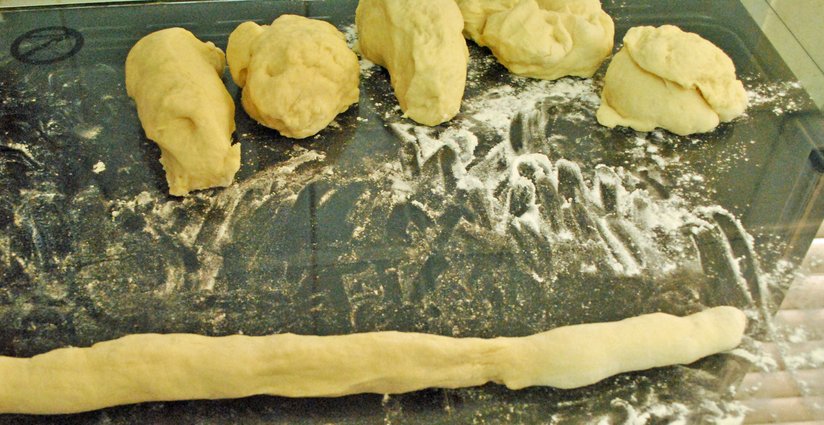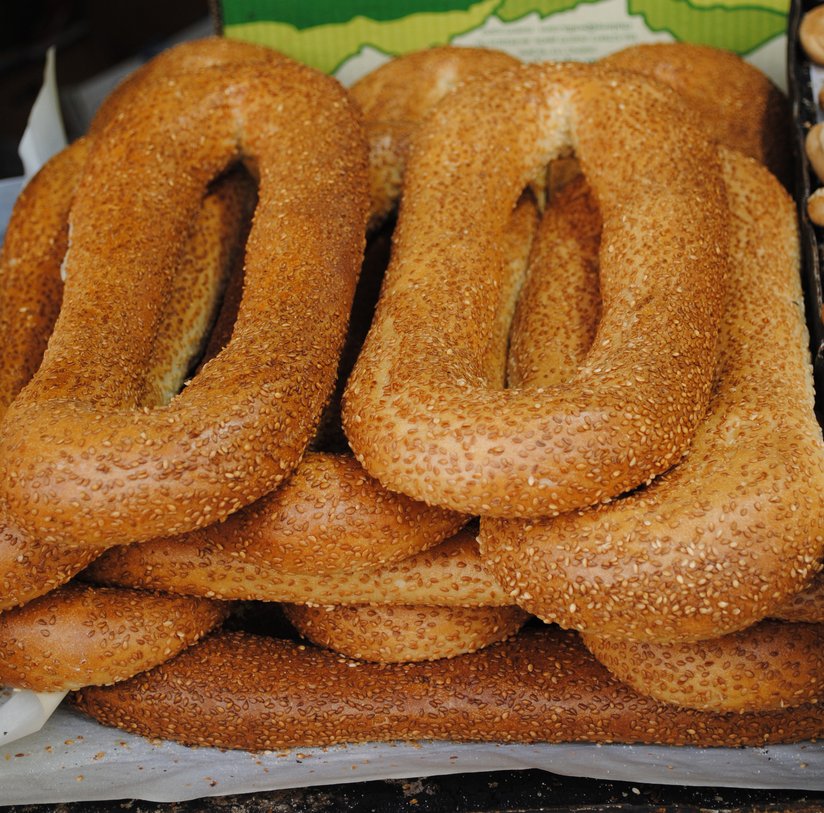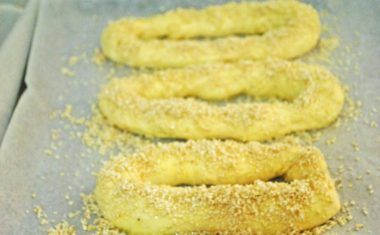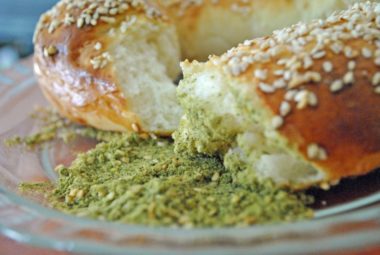
They say that the original recipe for these soft, elongated, slightly sweet bagels lies in the hearts of street vendors in Jerusalem. The knowledge is passed down from father to son, never to be revealed. Such is folklore. Israelis took to the bagels immediately and gave them the affectionate name “baygaleh,” then worked out how to bake them themselves. Now you can pick up a few, or a bagful, at most open-air markets and bakeries, even at little roadside kiosks. I’ve also seen roaming vendors hawking fresh “baygaleh” at traffic lights – a quick munch while you’re waiting for the light to change.
The truth is, these bagels aren’t at all hard to make at home. They require few ingredients and not many steps, but they do need a little time. They are a bread, after all. This recipe gives you the authentic just-barely-sweet, sesame-rich “baygaleh” flavor, with a crisp crust and distinctive soft interior. The bagels should be eaten as soon as they’ve cooled down, as they’re so light that they can dry out quickly. To keep them for later, store them in Ziploc bags and freeze them. Thaw the bagels out to room temperature and heat again for 2-3 minutes at 350° F (175° C).
If you can refrain from devouring these bagels while they’re still hot, I admire your willpower.
Jerusalem Bagels Recipe
PrintIngredients
- 4 1/4 cup all-purpose flour
- 3/4 ounce fresh yeast (or 3 1/2 teaspoons active dry yeast)
- 1 cup milk (plus 1/2 cup water, heated together until warm)
- 1/4 cup neutral-flavored oil (such as sunflower)
- 3 tbsp sugar
- 1 beaten egg
- 1/2 cup sesame seeds
- 2 tbsp sugar
Instructions
- Place the yeast in a large bowl with the water/milk mixture, the oil and the sugar. Stir gently and cover the bowl. Allow the yeast to rehydrate, 10 minutes. If using a mixer, use the mixer bowl.
- Whisk the yeast mixture together to disperse any lumps. Sift the flour over the liquid and mix in vigorously. If using a mixer, fit the dough hook and mix 10 minutes. If kneading by hand, knead 10 minutes. Either way, the dough should be smooth and a little tacky.
- Cover the bowl with plastic wrap or a recycled plastic bag and allow it to rise 30 minutes or until doubled in size.
- Sprinkle your work surface with flour. Divide the dough into sixths. Roll each sixth into a “snake” about 1 1/2 feet long.
- Join the ends and press them together. Hook a forefinger into the bottom of the hole that you just made, and gently stretch the dough to make a long hole.
- Preheat the oven to 350° F (175° C). Line two baking trays with baking parchment. Place the bagels on the trays with the joined side facing down. Brush well with the beaten egg, turning the tray to reach all sides of the bagels. It’s important to coat the bagels at this point and not wait until they’re ready to bake, because then they’ll be light and fragile and may collapse under the brush.
- In a small bowl, mix the sesame seeds and sugar. Sprinkle very generously over the bagels, again turning the tray to ensure that as much surface is covered with the seed/sugar mix as possible. It’s the sesame seeds that give the characteristic flavor to this bagel.
- Let the bagels rise 1/2 hour or until doubled in size.
- Bake 12-15 minutes, or until the bagels are golden and the bottoms are brown.
- Set on a rack to cool, covered with a towel.
- Traditionally, people just rip a chunk off and dip it into the dry za’atar spice mix. But Jerusalem bagels are fine as a snack by themselves, or as a great mopper-up of sauce at meal time.
Tips and notes:

When rolling the dough into long snakes, take care not to let an obnoxious skinny neck develop, which you can see on the right side of the rolled-out dough in the photo above. Those skinny places tend to break off, ruining the dough and obliging you to re-roll it. Roll gently, paying attention to the width of the snake, but don’t fuss if it’s irregular. Your handmade Jerusalem bagel is going to be delicious.



